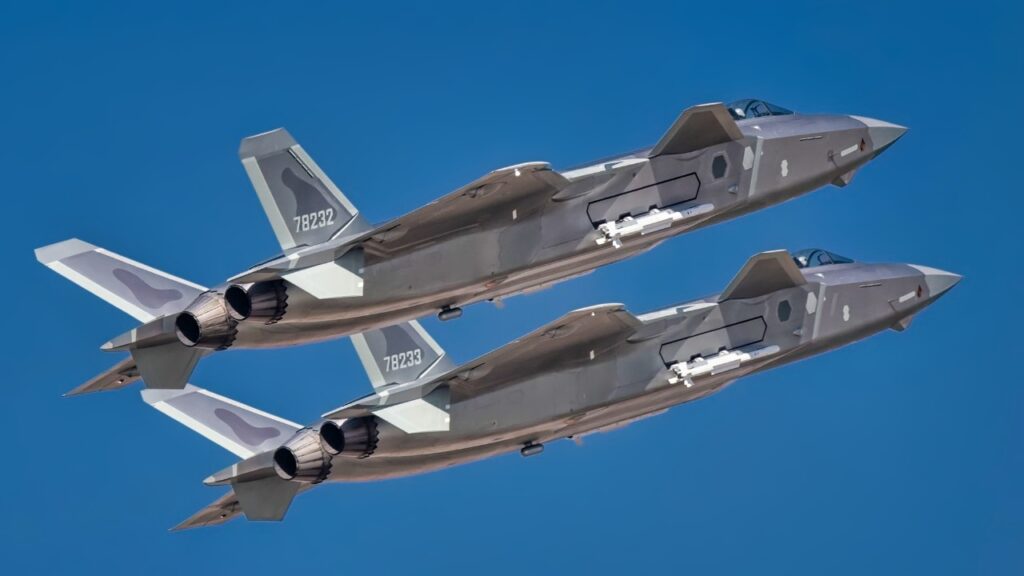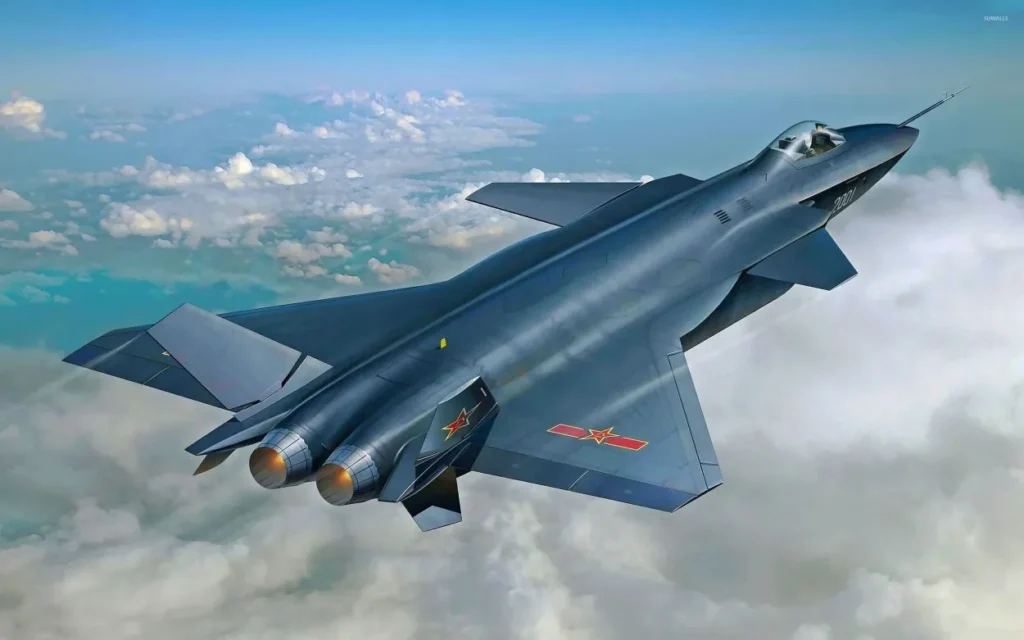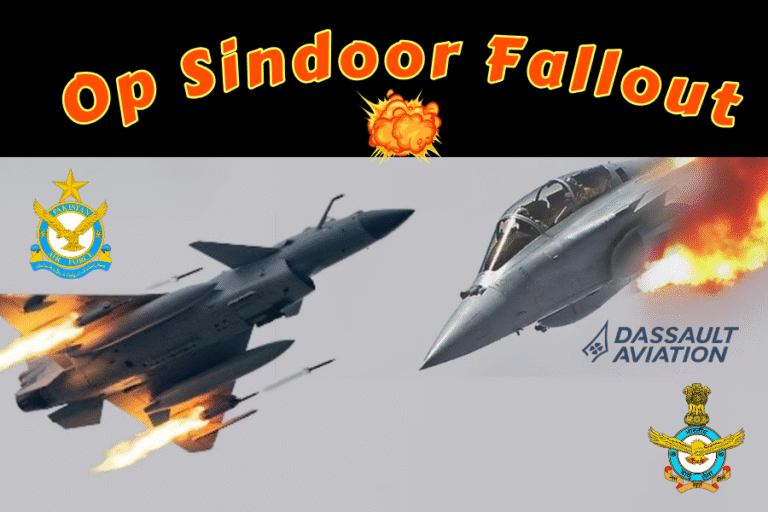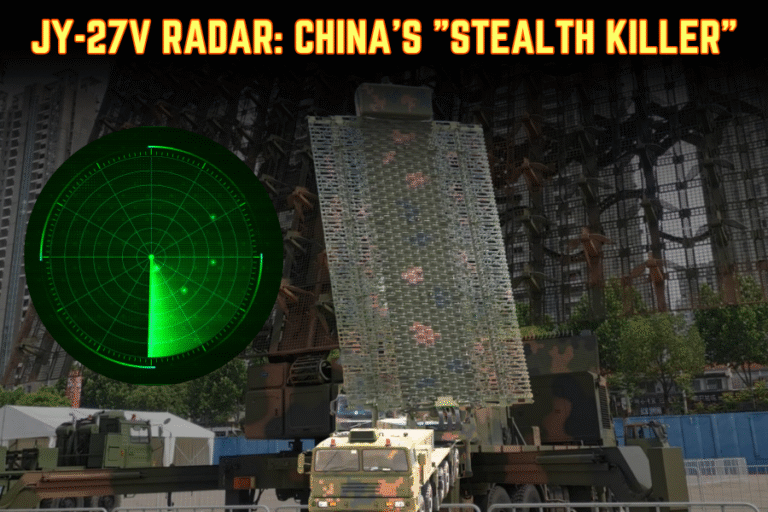(By Khalid Masood)
The Chengdu J-20, nicknamed the “Mighty Dragon,” represents China’s most advanced foray into fifth-generation stealth fighter technology. Developed by Chengdu Aerospace Corporation for the People’s Liberation Army Air Force (PLAAF), the J-20 is designed primarily as an air superiority fighter with precision strike capabilities. Since its maiden flight in January 2011 and induction into service in 2017, the J-20 has rapidly become a cornerstone of China’s ambition to challenge Western air dominance and assert regional power, especially in the Indo-Pacific theater.
Design and Technical Features
The J-20 is a twin-engine, single-seat stealth fighter featuring a canard-delta wing configuration optimized for agility and low radar cross-section. Its airframe employs radar-absorbent materials and angled surfaces to minimize detectability. Initially powered by Russian AL-31F engines, the J-20 is transitioning to indigenous Shenyang WS-10C engines, with the more powerful WS-15 engine planned to provide supercruise capability (sustained supersonic flight without afterburners).
Key avionics include the Chinese Type 1475 (KLJ-5) AESA radar, electro-optical/infrared targeting systems, and advanced communications suites with data links enabling network-centric warfare. The cockpit features a large glass canopy and a 24×9 inch primary LCD screen, enhancing pilot situational awareness.

The J-20 carries its armament internally to preserve stealth, with a main weapons bay housing four medium- to long-range air-to-air missiles (PL-12C/D, PL-15, and the extended-range PL-21) and two lateral bays for short-range PL-10 missiles. Four external hardpoints are available primarily for drop tanks during peacetime.
Performance Specifications
- Maximum Speed: Mach 2.0
- Combat Range: Approximately 2,000 km (1,200 miles)
- Service Ceiling: 20,000 meters (66,000 feet)
- Rate of Climb: 304 m/s (59,800 ft/min)
- Thrust-to-Weight Ratio: Estimated 0.92 with AL-31FM2 engines; expected improvement with WS-15
- Payload Capacity: Up to 27,998 lbs, surpassing many Western counterparts
Operational Role and Employment
The J-20 is intended to replace older fourth-generation fighters like the Su-27SK and Su-30MKK within the PLAAF. Its stealth, long range, and heavy payload capacity make it suitable for air superiority, deep strike, and potentially electronic warfare missions. A twin-seat variant is rumored to be in development for specialized roles including tactical bombing and carrier operations.
In the context of India, the J-20’s deployment adds a significant challenge to the Indian Air Force’s (IAF) air defense. Its stealth and long-range missile capability allow it to engage Indian fighters such as the Rafale from beyond visual range, potentially neutralizing India’s tactical advantages. The J-20’s range and payload also enable strikes deep into Indian territory, complicating India’s air defense posture.
Comparison with Rafale, Su-57, and F-35
| Feature | Chengdu J-20 | Dassault Rafale | Sukhoi Su-57 | Lockheed Martin F-35 |
|---|---|---|---|---|
| Generation | 5th | 4.5th | 5th | 5th |
| Stealth | Advanced (canard-delta design) | Limited (some radar reduction) | Advanced (stealth optimized) | Advanced (very low RCS) |
| Engines | 2 × WS-10C (transitioning to WS-15) | 2 × Snecma M88 | 2 × Saturn AL-41F1 | 1 × Pratt & Whitney F135 |
| Max Speed | Mach 2.0 | Mach 1.8 | Mach 2.25 | Mach 1.6 |
| Combat Range | ~2,000 km | ~1,850 km | ~1,500 km | ~1,100 km |
| Payload Capacity | ~12,700 kg (27,998 lbs) | ~9,500 kg | ~8,000 kg | ~8,160 kg |
| Radar | KLJ-5 AESA | RBE2-AA AESA | N036 Byelka AESA | AN/APG-81 AESA |
| Armament | PL-15, PL-21, PL-10 missiles | Meteor, MICA, SCALP | R-77, Kh-59 | AIM-120, JDAM, SDB |
| Supercruise | Planned with WS-15 | No | Yes | Yes |
| Operational Since | 2017 | 2004 | 2020 | 2015 |
Strengths and Weaknesses
Strengths of J-20:
- Superior payload capacity compared to F-35 and Rafale, enabling heavier strike loads.
- Long combat radius suitable for extended patrols and strikes in the Indo-Pacific.
- Advanced stealth features and AESA radar provide formidable BVR (beyond visual range) engagement capability.
- Indigenous engine development (WS-15) promises improved supercruise and maneuverability.
Weaknesses:
- Early engine variants (AL-31F) limit performance; indigenous engines still maturing.
- Canard design may increase radar signature compared to tailless stealth designs like F-35.
- Limited combat experience compared to Rafale and F-35, which have seen multiple conflicts.
- Sensor fusion and electronic warfare suites are believed to lag behind the F-35’s advanced integration.

Strategic Implications for India
The J-20’s presence complicates India’s air defense calculus. While the Rafale offers excellent multirole capabilities and proven combat performance, it lacks the range and payload to match the J-20’s deep strike potential. India’s reliance on a mix of Rafale, Su-30MKI, and indigenous AMCA development reflects attempts to counter Chinese stealth and long-range missile threats.
India’s Su-57 program, still in early production and limited deployment, offers a fifth-generation peer but faces challenges in engine development and numbers. The F-35, while not operated by India, remains a benchmark for stealth and sensor fusion technology.
Conclusion
The Chengdu J-20 “Mighty Dragon” is a formidable addition to the global fifth-generation fighter landscape. Its advanced stealth, long range, and heavy payload make it a key pillar of China’s airpower modernization and regional ambitions. While it currently faces some technological and operational challenges, ongoing upgrades and mass production aim to establish the J-20 as a dominant force in Asia’s skies.
For India, the J-20 represents a serious threat that demands continuous modernization and strategic partnerships to maintain air superiority. The evolving balance between the J-20, Rafale, Su-57, and other fifth-generation fighters will shape the future of aerial combat in South Asia and beyond.
References:
- SP’s Aviation, “J-20 of PLAAF and JF-17 of PAF Analysed” (2020)
- Wikipedia, “Chengdu J-20”
- Simple Flying, “Chengdu J-20: What You Need To Know About The Mighty Dragon”
- The National Interest, “China’s Mighty Dragon Jet Fighter Is Getting An Upgrade” (2025)
- Army Recognition, “China’s Chengdu J-20 and FC-31 Fighter Jets Emerge as Rivals to US F-35”
- Airforce Technology, “J-20 and China’s Military Modernisation”
- Financial Express, “Most Advanced Fighter Jets Globally in 2025”







